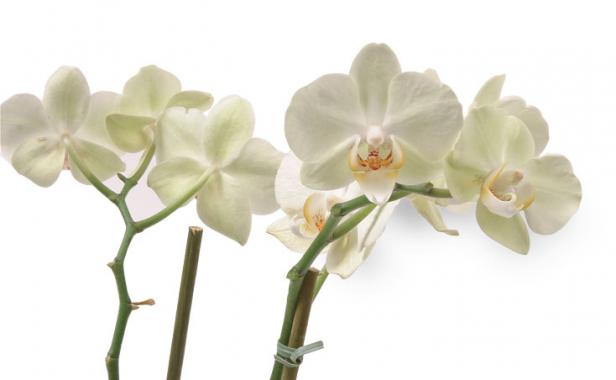How Do You Get An Orchid To Rebloom
Article
Why Won't My Orchid Rebloom?
Understanding the basic needs of orchids is the secret to spurring new buds

Orchids have a reputation for being finicky. And yet, if you take a trip to your local supermarket or garden store, there are dozens of orchids for $15 apiece, blooming under less-than-ideal conditions. What gives?
The hybrids for sale today have been bred for generations, not only for their big, bright, colorful flowers but also for their toughness, ease of growth, and dependable blooming. The ubiquitous moth orchid (Phalaenopsis spp. and cvs.) has passed poinsettia (Euphorbia pulcherrima and cvs.) as the world's number one potted plant precisely because it blooms for months at a time and survives under average household conditions. Problems occur, however, when it is treated like any other houseplant.
The bottom line is that orchids aren't difficult; they're just different. For starters, most orchids grow epiphytically—that is, aboveground on tree branches or rocks. Their thick, strong roots have adapted to anchoring onto bark or stone, and they are accustomed to the drenching-and-drying routine of tropical rainforests. They need air and space around them, which is why they rot in regular potting mix. In fact, roots are the key to growing healthy orchids. Following these basic care instructions will help ensure that your orchid has the strength to bloom year after year.
Boost energy levels with sunlight

As a rule, moth orchids prefer bright, indirect light—just enough to cast a shadow. This guideline works pretty well, especially when orchids are flowering. But here's the thing: Once the orchid finishes flowering, it needs energy to produce another flower spike. Just around the time when that spike should begin developing (late fall to early winter), daylight starts getting scarcer in the Northern Hemisphere. So what should you do? Your easiest solution is to move your orchid to a spot where it gets a few hours of direct morning or late-afternoon sun. This will ensure that the plant gets enough energy to make a spike with lots of flower buds. Introduce this stronger light gradually, however—over a week or so. If you think "more light, the better," think again. Taking an orchid from bright shade to full sun in one day is like going on vacation in midwinter from the streets of Fargo to the beaches of Cancún without suntan lotion. Ouch!
Besides sunlight, orchids also need fertilizer. There are a lot of fancy orchid fertilizers out there, with endorsements from top-notch growers. But the truth is, orchids don't care about brand names. All they need are regular, light feedings. Orchids can't absorb as much fertilizer as houseplants that grow in potting soil, and their roots burn if they receive too much fertilizer too quickly. (Remember, there aren't a lot of nutrients in those tree branches.) So memorize this simple mantra: "Weekly, weakly." Chant it daily. Post it on your fridge. And once a week, take whatever plant fertilizer you have, and use half the recommended dose when watering your orchids. In winter, cut it back to once a month, and on a monthly basis, wash away excess fertilizer salts by watering your orchids thoroughly in the sink. That's it. Done.
Never let the potting mix get soggy

Photo/Illustration: Scott Phillips
Most moth orchids do best in a mix of bark, perlite, and charcoal, which drains quickly but stays slightly moist for days. After a year or so, however, this bark mixture breaks down and stops providing the quick drainage and air circulation that orchid roots need. That's when it's time to repot. But before you bring a new bag of orchid potting mix to the cash register, pick it up and squeeze it. If it feels soft, like regular potting soil, instead of chunky, like bark mulch, put it back on the shelf. Too often, orchid mix sits around stores so long that it starts breaking down and becomes mushy. Using this old mix will cause your orchid's roots to rot.
Neglecting to repot, of course, isn't the only way to end up with soggy mix. Overwatering is the number one cause of death for indoor orchids. When an orchid is blooming, it's like a new pet: You give it lots of attention. But once the flowers fade, you start forgetting to water. Then, one day, you notice a leaf shriveling or an air root turning brown. To make up for your neglect, you start watering several times a week, instead of only once. A leaf drops; the roots keep shriveling. The orchid isn't thirsty: It's drowning, but it looks like it's drying up. Before you know it, you have a pot of muddy mix and a dying orchid. Don't let this happen to you. If you want flowers year after year, give your orchid adequate care while it's in bloom and out of bloom.
How to repot a moth orchid, step-by-step
In this photo slideshow , we break down the repotting process so you can get it right on the very first try.
Water only when the mix is dry, and never let an orchid sit in water. (Orchids are especially prone to root rot and disease when left soaking in water overnight or during the winter months.) To test whether it's time to water, gently stick your finger about an inch into the mix to check for dampness. When in doubt, wait a few days; orchids handle drought better than flooding.
Cut spent flower spikes for a stronger plant
After your moth orchid finishes blooming, snip off the flower spike near the base of the plant. An orchid needs to rest after flowering to build up energy for the following season. It was once common wisdom to cut the spike one or two nodes (the joints on the spike) above the base to encourage the spike to branch and develop new flowers. This second spike, however, is always smaller with fewer buds. It's far better to cut the spike and give your hardworking orchid a break. (Note: Some rare orchid species and hybrids rebloom on old spikes. If you're in doubt, contact the seller or your local orchid society.)
Give moth orchids warm days and cool nights
Almost everything we do as orchid growers is an attempt to re-create the orchid's natural habitat. For moth orchids, that means setting the room temperature at a level that is also comfortable for people: between 60°F and 80°F. The hardest thing to achieve indoors, however, is a temperature drop at night of 15°F to 20°F, which is typical in rainforests. Moth orchids, in particular, initiate a blooming spike in response to a month or so of cool nighttime temperatures, which mimics the climate conditions in Southeast Asia at the beginning of its rainy season. At home, you have two options: In early fall, keep your orchid near an open window at night (but don't let it get below 58°F), or keep the air-conditioning low during the day and turn it up at night.
Get our latest tips, how-to articles, and instructional videos sent to your inbox.
Related Articles
The Latest

Collection
Fall Bulb Planting for Your Region
Bulb-ordering season is here for much of the country, and many gardeners are rushing to nurseries and getting their online orders ready. It's important to plan ahead and make your…

Podcast: Let's Argue About Plants
Episode 99: Only Three Trees
The thought of restricting most gardeners to only three of any plant might sound cruel. After all, what makes us happier than heading to the nursery to fill a shopping…

Holiday Subscription Savings - Limited Time!
$10 for a year
of Fine Gardening Magazine
Subscribe Today
-

How-To
Giving Back Through Gardening: Part 2
Back in May, Fine Gardening committed to planning and planting a garden for Karen, an emergency department nurse. It was a small way to say thank you for the efforts…
How Do You Get An Orchid To Rebloom
Source: https://www.finegardening.com/article/why-wont-my-orchid-rebloom
Posted by: riosbroment.blogspot.com


0 Response to "How Do You Get An Orchid To Rebloom"
Post a Comment